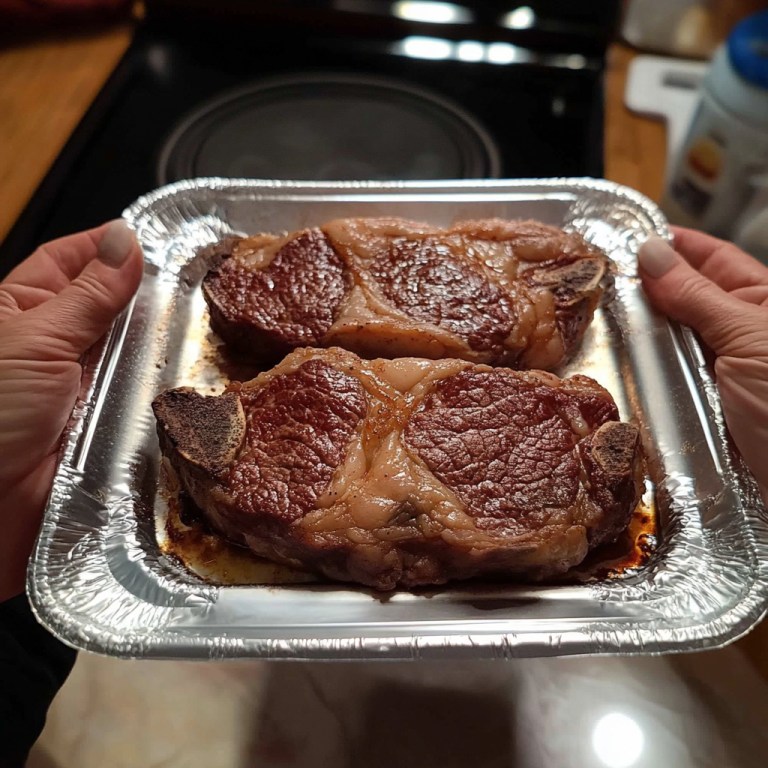ADVERTISEMENT
- Choose the Right Ribeye: Look for a ribeye steak that has ample marbling (fat running through the meat) and is a nice, rich red color. If you can, opt for a dry-aged ribeye for even more intense flavor. The thickness of the steak matters too—aim for at least 1 to 1.5 inches thick for the perfect balance of sear and tenderness.
- Room Temperature: Before cooking, remove your ribeye from the refrigerator and let it come to room temperature. This ensures even cooking, as cold meat straight from the fridge can result in uneven cooking.
- Seasoning: Simple seasoning is often the best. Generously season both sides of the ribeye with kosher salt and freshly ground black pepper. For extra flavor, you can add garlic powder, onion powder, or a drizzle of olive oil. If you want to add herbs, rosemary, thyme, or crushed garlic cloves are excellent choices to pair with beef.
2. Cooking Methods for Ribeye Steak
Grilling a Ribeye Steak
Grilling is one of the most popular methods for cooking ribeye steak, as it imparts a smoky flavor that pairs perfectly with the natural richness of the meat.
- Preheat the Grill: Get your grill hot and ready. If you’re using a charcoal grill, let the coals burn down to a medium-high heat. For gas grills, preheat to around 450°F-500°F.
- Sear the Steak: Place the ribeye on the grill and sear each side for 4-5 minutes, depending on thickness. This will give you that beautiful crust and char while keeping the inside tender and juicy.
- Check the Internal Temperature: Use a meat thermometer to check the internal temperature. For medium-rare, aim for 130°F-135°F; for medium, 135°F-145°F. Remember, the steak will continue cooking for a few minutes once you remove it from the grill.
- Rest the Steak: Let your ribeye rest for about 5-10 minutes before cutting into it. Resting allows the juices to redistribute throughout the meat, keeping it juicy.
Pan-Seared Ribeye Steak
Pan-searing is a great way to achieve a deep, flavorful crust on your ribeye steak. It’s a fantastic option if you don’t have access to a grill but still want that steakhouse-quality sear.
- Heat Your Skillet: Use a cast-iron skillet for the best results. Heat the skillet over medium-high heat and add a tablespoon of oil with a high smoke point, like canola or vegetable oil.
- Sear the Steak: Place the ribeye in the skillet and cook for 3-4 minutes on each side, until a rich golden-brown crust forms.
- Add Butter and Herbs (Optional): During the last minute of cooking, add a couple of tablespoons of butter, along with fresh rosemary or thyme and garlic cloves to the pan. As the butter melts, spoon it over the steak for added flavor.
- Check Internal Temperature: As with grilling, use a thermometer to check for doneness. For medium-rare, remove the steak at 130°F; for medium, take it off the heat at 140°F.
- Rest Before Slicing: After cooking, let the steak rest for 5-10 minutes before slicing into it. This step is crucial to keeping your steak juicy.
Oven-Broiling Ribeye Steak
Broiling is another excellent method for cooking ribeye steak, especially when you want a quick and easy way to cook indoors.
- Preheat the Broiler: Set your oven’s broiler to high and let it preheat for about 5 minutes. Place a rack about 4-6 inches from the heating element.
- Broil the Steak: Place the seasoned ribeye on a broiler-safe pan and broil for about 4-5 minutes on each side, depending on the thickness of the steak and your desired doneness.
- Check Internal Temperature: Broiling is fast, so it’s important to monitor the temperature with a meat thermometer to ensure you don’t overcook the steak.
- Rest and Serve: After broiling, let the steak rest for a few minutes before serving.
Tips for Perfect Ribeye Steak Every Time
- Use a Meat Thermometer: This is the easiest way to ensure your ribeye is cooked exactly the way you like it. Remember that the steak will continue to cook slightly while resting, so take it off the heat just before it reaches your desired temperature.
- Sear First, Then Cook: If you’re grilling or pan-searing, consider searing the steak over high heat to get that beautiful crust, then finish cooking it at a slightly lower heat to ensure it’s cooked through without drying out.
- Let It Rest: Don’t skip this step! Letting your ribeye rest for 5-10 minutes after cooking ensures the juices are reabsorbed into the meat, keeping it tender and juicy.
- Pair with a Sauce (Optional): While ribeye steak is delicious on its own, you can enhance the experience with a simple sauce like béarnaise, chimichurri, or a garlic butter sauce. These add an extra layer of richness to an already indulgent meal.
Conclusion: Ribeye Steak – A Meal Worth Savoring
A perfectly cooked ribeye steak is the ultimate indulgence for any steak lover. With its rich marbling, tender texture, and incredible flavor, it’s hard to beat. Whether you grill, pan-sear, or broil, using the right techniques and tools will help you achieve juicy, tender perfection every time.
So the next time you’re craving a delicious, flavorful steak, reach for the ribeye. With the right seasoning, cooking method, and a little patience, you’ll be able to enjoy one of the juiciest, most flavorful steaks you’ve ever had—and one that’s worthy of any special occasion or casual dinner.
ADVERTISEMENT
ADVERTISEMENT
